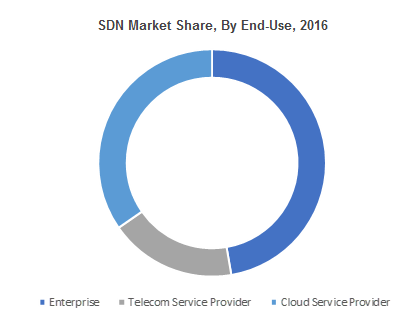Author: Sagar
U.S. is the leading country in the global SDN market due to the investment by the telecom service providers in SDN to improve their infrastructure capabilities to cope with the increasing network requirement. For instance, in 2017, telecom giant AT&T invested over USD 200 million to support SDN based start-ups. Global Software Defined Networking (SDN) Market size is set to exceed USD 88 billion by 2024.
SDN is an emerging network technology where the network control plane is isolated from the data plane and is directly programmable. It modifies the individual network devices into the accessible computing devices enabling the underlying infrastructure to be abstracted for network services and applications, which allow the network to be treated as a virtual entity. SDN enables the network to be a competitive differentiator for enterprises and carriers, not just an inevitable cost center. It offers several benefits, such as high bandwidth, capabilities to cope with the dynamic nature of the advanced application and reduction in operational & management complexity, that is augmenting its demand in the market.
The increasing adoption of the cloud services and IT convergence is one of the primary factor that is driving the growth of the market. Over the past five years, a rapid surge in the adoption of cloud services has been witnessed. It is driven by its capabilities to provide enterprise wide array of resources they can utilize to scale, orchestrate, and support their operations. Cloud computing untethers the underlying infrastructure and applications, offering a level of dynamism that did not exist in traditional infrastructure. Furthermore, as the demand of cloud computing increases, it will increase the pressure on the network to cope with the flexibility, scalability and programmability of this virtualized model. This results in ample use-cases for SDN and will fuel the demand for SDN market solutions.
Besides, increasing adoption of the SDN solution among the telecom service provider is also fueling the SDN market growth. The mobile traffic is increasing rapidly, and end-user needs are also evolving. This encourages telcos to pursue new network technologies to support the surge in the data traffic and connected nodes. To address these challenges of the traditional network infrastructure, SDN architecture is proposed. It can provide an efficient multi-tier network platform that decouples the data plane and network control and provides centralized control meeting the requirements of both evolving and future mobile networks.
Cloud service providers are one of the major end-users of the SDN market solutions. They are leveraging the capabilities of SDN to develop a cloud inter-network for increasing the scalability and flexibility of the cloud computing platforms. It provides a dynamic network infrastructure that can modify the traditional network into an excellent service delivery platform. Furthermore, SDN adoption in the cloud can enhance the security, network manageability, and dynamism in the data center, fueling the market growth.
The manufacturing industry is estimated to witness substantial growth during the forecast timeline. The growth of the SDN market is attributed to the increasing digitalization in the manufacturing industry and need to improve operational efficiency and reduce capital expenditure. SDN increases the operational flexibility of the manufacturing industry by allowing them to accelerate the application deployment and reduce the organization’s IT cost by workflow automation. The approach also has the capability to reduce the capital expenditure by reducing the cost of switches, routers, and other hardware component. These are the major factors that are augmenting the demand for the SDN market among manufacturers.
Asia Pacific SDN market is estimated to be the fastest growing region owing to the adoption of the cloud services. The investment by the telecom service providers in the region for enhancing the network infrastructure is also one of the primary factor driving the growth of the market. For instance, China’s telecom giants – China Unicom, China Mobile, and China Telecom are set to invest more than USD 180 billion by the year 2023 on 5G infrastructure, which is estimated to augment the growth of the market. In addition, improved internet penetration, mobile subscription and adoption of smartphones are also estimated to back the growth of the SDN market.
Some of the major vendors present in the SDN market are AT&T, IBM, HP, Cisco, Big Switch Network, Intel, Juniper, Huawei, Arista Network, NEC Corporation, Extreme Networks, Pluribus, Pics8 and Plexxi. Mergers & acquisitions are set to be the most common strategies used by the market players to improve their product portfolio, gain technical expertise, and acquire workforce. For instance, in 2015, Cisco acquired Embrane, a data center SDN solution provider, to strengthen its position in virtualization and SDN market.
